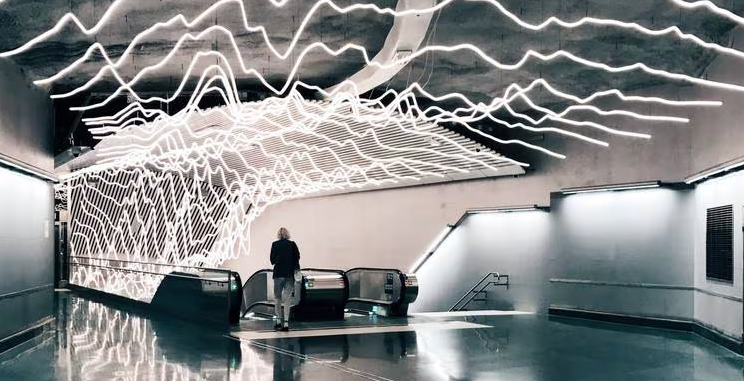It wasn’t until I delved into Stockholm’s subway system that I realized a train network wasn’t merely a mode of transportation; it could also serve as a repository for art and creative experiments. The inception of “art in the metro” in Stockholm traces back to the 1950 opening of the city’s first underground train line, connecting Slussen and Hokarangen stations. This artistic endeavor was inspired by the political ideology of Folkhemmet, or The People’s Home, championed by the Swedish Social Democratic party.
“People felt art needed to be more accessible to people on the streets instead of being the preserve of the rich and the famous,” explains Anders Nilsson, an art enthusiast I encounter while exploring Moderna Museet, the state museum for modern and contemporary art. “As Stockholm expanded, and many people moved to the suburbs, the subway system served well to connect the city and ensure that art was accessible to all.”
Today, the T-Bana, or tunnelbana, meaning tunnel railway in Swedish, boasts 100 stations, 47 underground and 53 above ground. It stands as an expansive 110-kilometer art gallery open to all, showcasing stunning murals, intricate paintings, and playful art installations.
In a city known for its dull, grey winters, the democratization of art has injected vibrancy into people’s daily commutes. For the price of a train ticket, one can explore 90 stations adorned with mosaics, paintings, sculptures, installations, reliefs, and engravings by over 150 artists. It offers an affordable and captivating journey through the evolution of art from the 1950s to modern experiments, featuring the works of many artists who have since become prominent figures in Sweden.
The ideal starting point for a T-bana tour is T-Centralen, the city’s main train station, where the three lines – red, blue, and green – intersect. T-Centralen, the first subway station built in Stockholm, gave birth to the concept of adding artwork to stations. Many of the original sculptures and paintings date back to the late 1950s, with the most memorable ones created by sculptor and painter Per Olof Ultvedt, including a piece with blue lines and floral motifs designed to evoke calm and quietude.
The blue line, stretching 25.5 kilometers between Kungstradgarden and Akalla/Hjulsta stations, offers a delightful journey. Stops like Hallonbergen showcase the imaginative world of children, with artists Elis Eriksson and Gosta Wallmark using doodles and scrawls to create a charming atmosphere reminiscent of a children’s fairy tale.
Solna Centrum presents one of the most iconic images in Stockholm’s Metro, featuring a cave-like station with a vividly painted sky and a sprawling 1,000-meter-long spruce forest. This artwork, created by Anders Aberg and Karl-Olav Bjork in 1975, serves as a powerful statement against environmental destruction during Sweden’s industrial era peak.
Kungstradgarden, the terminus of the blue line, boasts artwork inspired by the King’s Garden, one of Stockholm’s oldest public parks. The vibrant and abstract harlequin ceiling design, painted by Ulrik Samuelson in 1977, adds a lively touch to the cave.
Ostermalmstorg, designed in the 1960s as a nuclear attack shelter, features a political statement by painter and sculptor Siri Derkert. Using images highlighting women’s rights and world peace, Derkert showcases historical female figures and emphasizes the importance of these issues.
Hotorget, on the Green Line, is known as the “bathroom” station due to its light teal tilework and vintage signposts. Artist Gun Gordillo’s dramatic neon light installation in 1998 adds a unique and dynamic element to the station’s atmosphere.
The artistic decoration of subway stations has garnered praise from contributors like Christian Partos, who emphasizes the role of art in defining the space of otherwise architecturally neutral train stations. Partos’ contribution at Hasselby Strand station includes a focus on the elevator as a distinct element, using a yellow chromatic plate and a humorous tile pattern.
Morby Centrum, featuring colorful tilework creating optical illusions, showcases the artistic mission of Gosta Wessel and Karin Ek to portray the transformative nature of a journey.
Stadion station, near Ostermalms IP, stands out as a stunning showpiece with artwork by Ake Pallarp and Enno Hallek, serving as a reminder of Stadion’s significance in sports history. Despite initial controversy during its 1973 construction, the bright blue walls and rainbow artwork convey the message that there is a sky not far above.
The beauty of Stockholm’s subway system prompts frequent pauses, contrary to the typical hustle of commuter stations worldwide. Despite escalators, stairways, and bottlenecks, the T-bana offers more than just a journey – it provides a unique opportunity to time-travel through Swedish art and culture.



